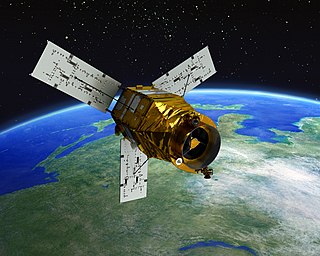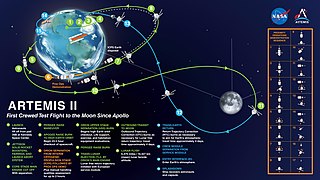
KOMPSAT or Korean Multi-Purpose Satellite is a series of South Korean multipurpose satellite for Earth observation, communications, meteorological, environmental, agricultural, and oceanographic monitoring applications.

KOMPSAT or Korean Multi-Purpose Satellite is a series of South Korean multipurpose satellite for Earth observation, communications, meteorological, environmental, agricultural, and oceanographic monitoring applications.
| Designation | Other name | COSPAR ID | SATCAT | Launch Date (UTC) | Launch vehicle | Launch Site | Orbit | Status | Remarks | Refs |
|---|---|---|---|---|---|---|---|---|---|---|
| KOMPSAT-1 | Arirang-1 | 1999-070A | 26032 | 21 December 1999 07:13 | Taurus | Vandenberg Air Force Base, United States | SSO | Deactivated | [1] [2] | |
| KOMPSAT-2 | Arirang-2 | 2006-031A | 29268 | 29 July 2006 07:05:43 | Rokot-KM | Plesetsk Cosmodrome, Russia | SSO | Active | [1] [3] | |
| KOMPSAT-3 | Arirang-3 | 2012-025B | 38338 | 17 May 2012 16:39 | H-IIA | Tanegashima Space Center, Japan | SSO | Active | [1] [4] | |
| KOMPSAT-5 | Arirang-5 | 2013-042A | 39227 | 22 August 2013 | Dnepr | Dombarovskiy Launch Site, Russia | SSO | Active | [1] [5] | |
| KOMPSAT-3A | Arirang-3A | 2015-014A | 40536 | 25 March 2015 | Dnepr | Dombarovsky Launch Site, Russia | SSO | Active | [6] | |
| GEO-KOMPSAT-1 | COMS 1 or Cheollian 1 | 2010-032A | 36744 | 26 June 2010 | Ariane 5 | Centre Spatial Guyanais, French Guiana | GEO | Deactivated | [7] | |
| GEO-KOMPSAT-2A | Cheollian 2A | 2018-100A | 43823 | 4 December 2018 | Ariane 5 | Centre Spatial Guyanais, French Guiana | GEO | Active | [8] [9] | |
| GEO-KOMPSAT-2B | Cheollian 2B | 2020-013B | 45246 | 18 February 2020 | Ariane 5 | Centre Spatial Guyanais, French Guiana | GEO | Active | [8] [9] | |
| KOMPSAT-6 | Arirang-6 | December 2024 | Vega-C | Centre Spatial Guyanais, French Guiana | SSO | Planned | [10] | |||
| KOMPSAT-7 | Arirang-7 | January 2026 | Vega-C | Centre Spatial Guyanais, French Guiana | SSO | Planned | [11] | |||

Ariane 5 is a retired European heavy-lift space launch vehicle developed and operated by Arianespace for the European Space Agency (ESA). It was launched from the Centre Spatial Guyanais (CSG) in French Guiana. It was used to deliver payloads into geostationary transfer orbit (GTO), low Earth orbit (LEO) or further into space. The launch vehicle had a streak of 82 consecutive successful launches between 9 April 2003 and 12 December 2017. Since 2014, Ariane 6, a direct successor system, is in development.

The Guiana Space Centre, also called Europe's Spaceport, is a European spaceport to the northwest of Kourou in French Guiana, a region of France in South America. Kourou is located approximately 310 mi (500 km) north of the equator at a latitude of 5°. In operation since 1968, it is a suitable location for a spaceport because of its equatorial location and open sea to the east.

Vega is an expendable launch system in use by Arianespace jointly developed by the Italian Space Agency (ASI) and the European Space Agency (ESA). Development began in 1998 and the first launch took place from the Guiana Space Centre on 13 February 2012.

Rokot, also transliterated Rockot, was a Soviet Union space launch vehicle that was capable of launching a payload of 1,950 kilograms (4,300 lb) into a 200-kilometre (120 mi) Earth orbit with 63° inclination. It was based on the UR-100N intercontinental ballistic missile (ICBM), supplied and operated by Khrunichev State Research and Production Space Center. The first launches started in the 1990s from Baikonur Cosmodrome out of a silo. Later commercial launches commenced from Plesetsk Cosmodrome using a launch ramp specially rebuilt from one for the Kosmos-3M launch vehicle. The cost of the launcher itself was about US$15 million in 1999; The contract with European Space Agency (ESA) for launching Swarm in September 2013 was worth €27.1 million.

Aeolus, or, in full, Atmospheric Dynamics Mission-Aeolus (ADM-Aeolus), was an Earth observation satellite operated by the European Space Agency (ESA). It was built by Airbus Defence and Space, launched on 22 August 2018, and operated until it was deorbited and re-entered the atmosphere over Antarctica on 28 July 2023. ADM-Aeolus was the first satellite with equipment capable of performing global wind-component-profile observation and provided much-needed information to improve weather forecasting. Aeolus was the first satellite capable of observing what the winds are doing on Earth, from the surface of the planet and into the stratosphere 30 km high.

Thales Alenia Space is a joint venture between the French technology corporation Thales Group (67%) and Italian defense conglomerate Leonardo (33%). The company is headquartered in Cannes, France.

KOMPSAT-2, also known as Arirang-2, is a South Korean multipurpose Earth observation satellite. It was launched from Plesetsk Cosmodrome, Russia at 07:45:43 UTC on 28 July 2006. It began to transmit signals at 14:00 UTC the same day. Like the earlier KOMPSAT-1 satellite, it takes its name from the popular Korean folk song Arirang. Its launch was the culmination of a project begun in 1995.
The Living Planet Programme (LPP) is a programme within the European Space Agency which is managed by the Earth Observation Programmes Directorate. LPP consists of two classes of Earth observation missions including research missions known as Earth Explorers, and the Earth Watch class of missions whose objective is to develop support operational applications such as numerical weather forecasting or resource management.

KOMPSAT-3, also known as Arirang-3, is a South Korean multipurpose Earth observation satellite. It was launched from Tanegashima Space Center, Japan at 16:39 UTC on 17 May 2012. Like the earlier KOMPSAT-1 and KOMPSAT-2 satellites, it takes its name from the popular Korean folk song Arirang. Its launch was the culmination of a project begun in 1995.

EarthCARE is a planned joint European/Japanese satellite, the sixth of ESA's Earth Explorer Programme. The main goal of the mission is the observation and characterization of clouds and aerosols as well as measuring the reflected solar radiation and the infrared radiation emitted from Earth's surface and atmosphere.
SEOSat-Ingenio, was a Spanish project to produce a satellite capable of providing wide-field imagery ensuring a repeat cycle of 38 days at 2.5 metre panchromatic resolution and 10 metre colour resolution, from a Sun-synchronous polar orbit; it was Spain's first optical imaging satellite. The satellite was part of the Spanish Earth Observation Satellite program. The mission was funded by Spain's Centre for the Development of Industrial Technology (CDTI). SEOSat-Ingenio information was to be used by various Spanish civil, institutional or government users. However, under the Copernicus Programme of the European Union, it was also accessible to other European users, as well as to the Group on Earth observation of the Global Observing System of Earth.
ELA-4, is a launch pad and associated facilities at the Centre Spatial Guyanais in French Guiana located along the Route de l'Espace in the Roche Christine site, between ELA-3 and ELS launch facilities. The complex is composed of a launch pad with mobile gantry, an horizontal assembly building and a dedicated launch operations building. ELA-4 is operated by Arianespace as part of the Ariane 6 program. As of November 2022 the first launch is scheduled for the fourth quarter of 2023.

Satrec Initiative or SI is a South Korean satellite manufacturing company headquartered in Daejeon, South Korea The company was founded in 1999 by the engineers who developed the first Korean satellite (KITSAT-1) at KAIST SaTRec. The company designs and builds Earth observation satellites called SpaceEye-series, and it provides various space components, including high resolution electro-optical payloads and star-trackers. SI's first satellite was a Malaysian Earth observation satellite, RazakSAT launched in 2009. SI has two subsidiaries: SI Imaging Services (SIIS) is the exclusive image data provider of KOMPSAT-series, and SI Analytics (SIA) provides AI-native GEOINT solutions for satellite imagery. SI also spun-off SI Detection (SID), which provides radiation monitoring solutions.

Vega flight VV15 was the 15th flight of the Vega launcher, and its first failure.

This article documents expected notable spaceflight events during the year 2026.

This article documents expected notable spaceflight events during the year 2025.

This article documents expected notable spaceflight events during the year 2027.